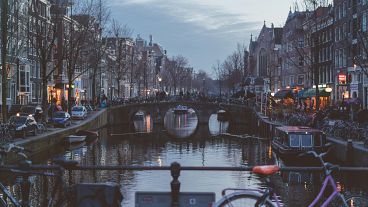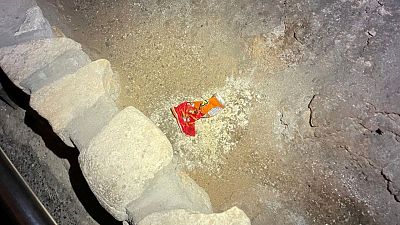From post-coital lions to sleeping seals, marvel at some of this year's best wildlife photography
The images showcase a diverse range of animal behaviour and conservation issues.
A leaping stoat, a ball of bees and a David Bowie spider are some of the best images submitted to this year’s Wildlife Photographer of the Year competition.
Now in its sixtieth year, the competition attracted a record-breaking 59,228 entries from photographers of all ages spanning 117 countries and territories.
“In this selection, you see species diversity, a range of behaviour and conservation issues,” says chair of the judging panel, Kathy Moran.
“These images represent the evolution of the competition through the years, from pure natural history to photography that fully embraces representation of the natural world - the beauty and the challenges. It is a powerful selection with which to kickstart a milestone anniversary.”
The winners from each category and Grand Title and Young Grand Title awards will be announced at a ceremony on 8 October hosted by wildlife TV presenters and conservationists Chris Packham and Megan McCubbin.
The upcoming Wildlife Photographer of the Year exhibition will showcase 100 photographs from around the world starting 11 October 2024 in London. To mark the sixtieth anniversary, the museum’s flagship exhibition will feature a timeline of key moments in the competition’s history.
Here’s a sneak peek of some of the Highly Commended competition entries for this year - including the first-ever awarded image taken on a smartphone.
Centre of Attention by Georgina Steytler, Australia: Highly Commended, Behaviour: Invertebrates
This ball of male Dawson’s burrowing bees is vying for access to a female. When females emerge in the spring, they are surrounded by males competing to mate with them. After mating, the female bee digs a new burrow filled with pollen and eggs from which newly hatched bees will emerge in the spring.
Australian photographer Georgina Steytler has been studying these bees for years and knew to keep her distance. A long lens enabled her to catch this image as she lay on the hot, rocky ground near Carnarvon Western Australia, with sand blowing in her face.
Deadly Bite by Ian Ford, UK: Highly Commended, Behaviour: Mammals
A radio call alerted British photographer Ian Ford that a jaguar had been spotted prowling the banks of the São Lourenço River tributary in Pantanal, Mata Grosso, Brazil. Kneeling in the boat, he got the prefect shot as the cat delivered a blow to the unsuspecting yacare caiman.
The South American Pantanal wetlands have the highest density of jaguars found anywhere in the world. As prey is abundant, these usually solitary big cats have been seen fishing, playing and travelling together.
Twist and Jump by Jose Manuel Grandío, Spain: Highly Commended, Behaviour: Mammals
Spanish photographer Jose Manual Grandío braved below-zero temperatures in Athose, Bourgogne-Franche-Comte, France to witness a stoat jumping through the snow.
Grandío’s favourite season for photography is winter and he spotted the creature leaping high into the air on the last day of his trip.
He says he saw the performance as an “expression of exuberance’. Scientists refer to this behaviour as dancing, though opinions are divided about what motivates it from an attempt to confuse prey to a parasitic infection.
The Last Resting Place by Randy Robbins, USA: Highly Commended, Natural Artistry
Struck by the unusual beauty of this frosted deer on the forest floor, photographer Randy Robbins captured this image on his smartphone.
Robbins was checking trail cameras near his home in Susanville, California in the US when he found the animal’s body. He snapped the poignant moment before the ice could melt.
In the Spotlight by Shreyovi Mehta, India: Runner-Up, 10 Years and Under
Young photographer Shreyovi Mehta was walking in Keoladeo National Park, Rajasthan, India with her parents when she spotted this scene. She ran back to her dad who was carrying the cameras and got down low to take a photograph from a low angle.
Keoladeo National Park is renowned for its birdlife and attracts large numbers of water birds in the winter. Peafowl, as seen in the photo, are year-round residents. Roosting in large trees, they are more active during dawn and dusk and rest in the shade during the day.
Going with the Floe by Tamara Stubbs, UK: Highly Commended, Animals in their Environment
This image represents a standout moment in UK photographer Tamara Stubbs’s nine-week expedition in the Weddell Sea. She noticed that these crabeater seals had fallen asleep alongside the ship with the tips of their nostrils above the surface of the water.
There are roughly four million crabeater seals in the Antarctic. Though they aren’t considered endangered or threatened, they are protected by international conservation agreements. More research is needed on how climate change and tourism are impacting their populations.
The Disappearing Ice Cap by Thomas Vijayan, Canada: Highly Commended, Oceans: The Bigger Picture
Thomas Vijayan’s drone shot shows the epic scale of the Bråsvellbreen glacier in Svalbard, Norway. It required meticulous planning and good weather conditions to pull it off with the final image a panorama of 26 individual frames.
The photo shows summer meltwater plunging off the edge of the Bråsvellbreen glacier. It is part of Austfonna, Europe’s third largest ice cap, which is one of several that cover the land area of the Svalbard archipelago.
Some scientific models suggest that Svalbard’s glaciers could disappear completely within 400 years due to climate change.
Stormy Scene by William Fortescue, UK: Highly Commended, Behaviour: Mammals
British photographer William Fortescue visited the Serengeti National Park in Tanzania during the rainy season. He watched these lions mate several times before the female broke it off, not noticing the trails of saliva and the explosion of insects from the male’s mane until he later enlarged the photo.
Lions can mate throughout the year but synchronise the birth of cubs to increase pride’s chances of success. Female lions cooperate to raise these offspring together, helping ensure their survival into adulthood.
Moonlight Hunter by Xingchao Zhu, China: Highly Commended, Behaviour: Mammals
Xingchao Zhu tracked a group of wild Pallas cats on the freezing plateau of Inner Mongolia for several days over Chinese New Year. Just before dawn on one of the days, Xingchao made eye contact with this cat as it caught a small bird.
Pallas cats have thick winter coats that help them survive at altitudes of up to 5,000 metres. They use stealth to avoid large predators and it's thought that their small, rounded ears allow them to stay hidden while peering over obstacles.
Hooked by Tommy Trenchard, South Africa: Highly Commended, Oceans: The Bigger Picture
South African photographer Tommy Trenchard was travelling on the Greenpeace ship Arctic Sunrise when he got this photo of the bycatch of a requiem shark.
Arctic Sunrise’s research expedition in international waters in the South Atlantic Ocean aimed to document the bycatch or accidental capture of sharks by fishing boats targeting tuna and swordfish.
With approximately 80 million sharks taken from the world’s oceans each year, it hoped to highlight the lack of regulation of industrial-scale fishing in international waters.
Shark numbers worldwide have dropped since 1970 due to fishing with three-quarters of all shark species now at risk of extinction.
Wildlife Photographer of the Yearis developed and produced by the Natural History Museum, London.

























